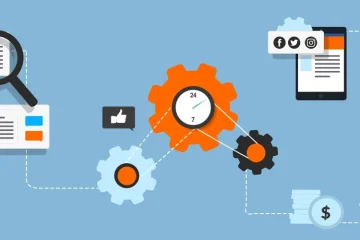Step-by-Step Guide to Tech Stack Optimization for Sustainable Growth

In the fast-evolving world of business and technology, companies are increasingly relying on a robust and efficient tech stack to drive growth. A well-optimized tech stack not only enhances operational efficiency but also ensures scalability, reduces costs, and allows for faster time-to-market. For startups and established businesses alike, building and refining a tech stack that aligns with long-term objectives is key to sustaining growth.
The term “tech stack” refers to the collection of technologies—software, hardware, and tools—that a company uses to develop, operate, and maintain its digital infrastructure. This stack can include everything from programming languages and frameworks to databases, APIs, and cloud services. However, merely having the right tech stack isn’t enough. It must be continually optimized to adapt to changing business needs, technological advancements, and shifting market demands.
This step-by-step guide outlines the essential actions for optimizing your tech stack to ensure sustainable business growth.
Step 1: Assess Your Current Tech Stack
Before making any changes, the first step in tech stack optimization is a comprehensive assessment of your existing tools and technologies. Many companies fall into the trap of accumulating tech assets over time without fully understanding how each component contributes to their operations.
Begin by answering the following questions:
-
What technologies are currently in use? Create a list of all the technologies across different departments, from development tools to customer relationship management (CRM) platforms.
-
How do these tools integrate with each other? Evaluate the level of integration between your various systems and tools. Seamless integration is crucial for efficiency.
-
Are there redundancies? Look for overlap in functionality. For instance, if you’re using multiple project management tools or CRMs, determine whether they provide unique value or if consolidating could reduce complexity.
-
What are the pain points? Identify bottlenecks and inefficiencies in your current system. Are there recurring problems such as slow performance, difficulty in scaling, or poor user experience?
-
How well do they align with your business goals? Ensure that the tools you are using are conducive to your company’s growth strategy.
This assessment will give you a clear understanding of where your tech stack stands and where improvements are needed.
Step 2: Define Business Goals and Technological Requirements
Tech stack optimization must always be aligned with your business goals. Without a clear understanding of what you want to achieve, optimizing your tech stack could lead to misguided decisions or investments in the wrong areas.
Consider the following:
-
Scalability: As your business grows, so should your tech stack. Define your scalability needs—whether you anticipate rapid expansion in users, products, or geographic regions. Ensure your stack can scale efficiently without compromising performance or incurring excessive costs.
-
Innovation and Adaptation: Think about future technological trends and how they could impact your business. For instance, if you foresee a greater reliance on artificial intelligence, cloud computing, or machine learning, make sure your stack is adaptable to these technologies.
-
Customer Experience: A core driver of business success is a seamless and engaging customer experience. If customer service, user interfaces, or personalization are central to your strategy, select tools that can deliver exceptional customer experiences at scale.
-
Cost Optimization: Technology expenses can accumulate quickly, especially as businesses grow. Optimize your tech stack to balance cost with performance. This may mean consolidating tools or choosing more cost-effective alternatives without compromising on functionality.
Once you have defined your business goals, you’ll have a clearer picture of the types of technologies your company needs to achieve them.
Step 3: Streamline and Consolidate Technologies
Over time, organizations often accumulate an array of tools that serve similar purposes, leading to inefficiencies and unnecessary costs. Streamlining and consolidating your technologies can simplify processes and reduce technical debt.
-
Eliminate redundancies: As mentioned in the assessment phase, identify any overlap in tools. For instance, using multiple communication platforms such as Slack, Microsoft Teams, and email for internal messaging can create unnecessary complexity. Consolidating into one platform can improve efficiency.
-
Choose all-in-one solutions when possible: Opt for comprehensive solutions that can replace multiple specialized tools. For example, an integrated platform like HubSpot can combine CRM, marketing automation, and sales analytics, reducing the need for separate systems and improving data consistency.
-
Standardize across the organization: Different departments often adopt different tools based on their immediate needs. Standardizing the tools across the company can improve collaboration, data sharing, and overall productivity.
Streamlining your tech stack leads to smoother workflows, faster decision-making, and better collaboration across teams.
Step 4: Prioritize Scalability and Flexibility
A tech stack that works well today may not be sufficient for tomorrow’s demands. As your business grows and evolves, your tech stack must scale accordingly. When selecting or optimizing your tools, consider the following scalability factors:
-
Cloud Services and Infrastructure: Cloud platforms such as AWS, Google Cloud, or Microsoft Azure offer flexible, on-demand resources that can grow with your business. Whether you need to expand storage, computing power, or hosting capacity, cloud services provide scalability without the need for heavy upfront investments in hardware.
-
Modular Architecture: A modular tech stack enables easy addition or removal of components. For example, adopting microservices architecture allows your development team to scale specific parts of your application without disrupting the entire system.
-
Automation Tools: As you scale, automation tools can help streamline repetitive tasks, allowing your team to focus on more strategic initiatives. Marketing automation, workflow automation, and robotic process automation (RPA) can help reduce manual efforts and increase operational efficiency.
-
Integration Capabilities: A scalable tech stack must be able to integrate with new tools or platforms as your business evolves. Ensure your stack is compatible with APIs and third-party applications that can be added as needed.
Scalability and flexibility ensure that your tech stack remains future-proof, allowing you to adapt to new business demands without significant disruption.
Step 5: Focus on Data Security and Compliance
In an era where data breaches are commonplace, ensuring that your tech stack is secure is paramount. The tools and platforms you select must comply with industry standards and regulations to protect sensitive information, such as customer data, financial records, and intellectual property.
-
Data Encryption and Secure Storage: Ensure that your chosen technologies provide strong encryption methods to protect data both in transit and at rest. Cloud service providers like AWS offer built-in security features such as encryption and identity management to safeguard sensitive data.
-
Compliance with Regulations: Depending on your industry, you may need to comply with regulations like GDPR, HIPAA, or CCPA. Ensure that your tech stack includes tools that support compliance requirements, such as data anonymization, consent management, and audit trails.
-
Regular Security Audits: Schedule routine security audits and vulnerability assessments to identify potential risks. Additionally, monitor your stack for unauthorized access or breaches, and implement mechanisms for real-time alerts.
Data security and compliance not only protect your business but also build trust with customers, which is crucial for long-term success.
Step 6: Invest in Training and Support
A tech stack is only as effective as the people who use it. Investing in proper training and support for your team members ensures that they can fully leverage the capabilities of your tech stack.
-
Training Programs: Offer comprehensive training on new tools, technologies, and processes. This will help employees become proficient in using the tools, ultimately improving productivity.
-
Ongoing Support: Ensure that your team has access to support resources, such as troubleshooting guides, user forums, and dedicated help desks, to resolve issues quickly and avoid disruptions.
-
Encourage Feedback: Create channels for team members to share feedback on the tools they use. Regular feedback helps identify pain points and areas for improvement, enabling you to make informed decisions about future optimizations.
Investing in training and support fosters a culture of innovation and ensures that your tech stack delivers maximum value.
Step 7: Continuously Monitor and Evaluate Performance
Tech stack optimization is not a one-time task; it requires ongoing monitoring and evaluation to ensure it remains aligned with your business objectives. Regularly assess how your tools are performing, and keep an eye on emerging technologies that could improve your stack further.
Key performance indicators (KPIs) to track include:
-
System Uptime and Reliability: Ensure that your tech stack is consistently operational and free of downtime.
-
Operational Efficiency: Measure the impact of automation, streamlined processes, and consolidated tools on productivity.
-
Cost-Effectiveness: Track the cost savings achieved through tech stack optimization, including reduced software licenses, maintenance costs, and resource consumption.
-
Scalability Metrics: Monitor your stack’s ability to handle growing traffic, users, or transactions without performance degradation.
By continuously refining your tech stack, you can maintain agility, improve efficiency, and stay ahead of competitors.
Conclusion
Optimizing your tech stack for sustainable growth requires careful planning, strategic decision-making, and ongoing evaluation. By assessing your current tools, aligning them with business goals, prioritizing scalability, ensuring security, and providing proper training, you can build a tech stack that supports long-term success. Remember, tech stack optimization is an iterative process—by staying flexible and responsive to changing needs, you can ensure your business is well-equipped to scale and thrive in an increasingly complex technological landscape.
Critical Factors in Automation in Business Explained
February 9, 2025The Future of Automation in Business Used by Top Companies
January 6, 2025
Comments are closed.
Recommended
-
Top 10 Hospitality Recovery Strategies That Scale
January 6, 2025 -
Benefits of Growth Hacking for Startups
March 2, 2025
Top Posts
Recent Posts
- Optimising Heat Management: Precision Cooling for Peak Performance July 31, 2025
- Why are gift cards a great option for retirement gifts? July 27, 2025
- Top 10 Automation Tools in Business Used by Top Companies May 14, 2025
- Emerging Tools for Influencer Marketing Used by Top Companies May 14, 2025
- Best Practices for Cost Reduction Tactics You Didn’t Know May 6, 2025
Categories
- Business (6)
- E-commerce & Online Business (5)
- Finance & Accounting (5)
- HR & Hiring (5)
- Industries (5)
- Legal & Compliance (5)
- Management & Growth (5)
- Marketing & Branding (5)
- Technology & Tools (6)
Archives
- July 2025 (2)
- May 2025 (4)
- April 2025 (5)
- March 2025 (6)
- February 2025 (12)
- January 2025 (15)
- December 2024 (1)
- November 2024 (1)
- February 2021 (1)








